Tagged: socialmedia
Simple Steps to Build Your Personal Brand
- by Alyson Shane
If you're anything like me, you spend an egregious amount of time online chatting, sharing comments, articles and opinions, and connecting with other people.
If you don't, or if you're just starting to, then you may not be familiar with the concept of personal branding, and how it can help you achieve your personal and business goals.
What Is Personal Branding?
Your personal brand is how people in your community and the world at large think about you. It's the sum-total of all of your activity online, which helps paint a picture of who you are to the people who know you through online social channels like Facebook, Twitter, LinkedIn, Pinterest (to name a few), and your website, if you've got one.
Having an understanding of personal branding is a powerful tool because it allows you to actively shape how people see you, and gives a focus and direction of the tone, quality, and direction of the content you share.
In this post we're going to cover a few simple ways that you can build a strong personal brand which not only reflects the fabulous person that you are, but also how it can help you achieve your goals!

Build a Website That Reflects Who You Are
I'd argue that the most important piece of the puzzle regarding your personal brand is having a website that you love. Something sleek, cool, easy-to-navigate and which accurately represents who you are to the world.
Your website should have an active blog, and should act as the hub for all of your activity online, with your social media feeds regularly linking back to it. Blogging not only helps with SEO (search engine optimization) which is how people find your website, but also helps people gain a better understanding of who you are through what you write and share.
Back in the day people (like me) wrote lifestyle blogs, which were basically like online journals and didn't really exist to serve a purpose other than somewhere for us to publish our thoughts. These days, though lifestyle blogs still exist, they aren't as frequent, and blogging has taken on a more professional quality.
If you're a professional, blogging regularly about events in your industry and sharing ideas and opinions is a great way to help your audience understand who you are. Though I'd argue that lifestyle blogging even has a place, too! While blogging about your industry is great, people still want to see who you are, which is why sharing posts about things you've done, events you've attended, or experiences that you've had are also valuable content.
Explore & Be Your Authentic Self
I write about authenticity a lot, and one of the reasons that I keep coming back to it is because who you are and how you craft your personal brand can make or break your future prospects. if people think you suck, they won't want to work with you.
Luckily being your authentic self is easy: you just have to be who you are.
I've read suggestions on other blogs and websites that suggest trying to craft a "fake" version of yourself; someone who reacts to things differently than you normally would, and makes statements that contradict how you actually feel about an issue. I totally disagree with these suggestions.
Personal branding is about nurturing the best parts of ourselves, being honest and vulnerable, and sharing those parts of ourselves with the world. We're all flawed human beings who are in a constant state of growth, and part of crafting a personal brand is being open about who we are, in as much (or as little) detail as we're comfortable sharing.
Some key things that your personal brand helps people understand are:
- What do you believe?
- What are your goals and ambitions?
- What are your strengths and weaknesses?
- What kind of client/contractor/employee/business owner are you?
- On a scale of 1-10, how much do you love inspirational sloths?

(okay, that last one was just me)
Remember: people connect with other people. Being authentic builds trust.
If you don't appear to be a real human being, or seem like you're faking your way through everything (aka being full of shit) how will people trust you it they don't feel like they know the real you?
One last thing:
Being your authentic self also means that you'll rub people the wrong way. There's always going to be someone out there, naysaying whatever you blog about, share, or reflect on publicly. That's okay. To quote the ever-wise Taylor Swift "the haters gonna hate, hate, hate, hate, hate."
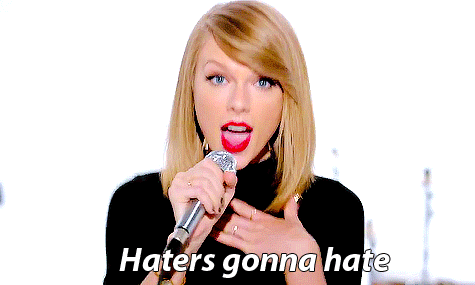
Get Speaking
One of the easiest ways to build up your personal brand is to speak publicly about what you do. Whether it's at a conference, a local meetup, or to a classroom full of students, speaking about what you do not only builds awareness of you and your personal brand, but (bonus!) it'll help you be better at what you do.
If you're not used to speaking it can be really daunting, but a bit of practice and some great reference material (I like to make my own slides using Keynote) you'll have a whip-smart presentation in no time. Additionally, having to break down complex ideas, concepts, or speak about your strategy or workflow can be immensely helpful in helping you develop clearer way to communicate it to everyone else.
Case in point: last April I spoke about the importance of social media at the Manitoba Trucking Association's Driving the Future conference. While I discuss social media with my peers and clients on a regular basis, having to explain things like Twitter to a non-user helped me develop a better understanding of how to convey important ideas. That presentation is what led me to develop my Twitter for Beginners series. How cool!
When you speak do so from a place of knowledge and power and show that you know what you're talking about. Speaking engagements not only help people understand what you do and who you are, but they're also terrific confidence-builders, too. Win/win!
Write About What You Do & Participate in Interviews
Thought leadership articles (like the one you're reading) which provide advice, insight and reflection into what you do help give you major cred. Thought leadership articles not only give you the opportunity to discuss what you do from the comfort of your own keyboard, but can also provide valuable research and learning opportunities as you fact-check and find references to back yourself up, as well (cha-ching!)
I'm a big proponent of knowledge sharing, and I believe that it's single best way to make people aware of what I do. Not just that, but it helps people, too! How awesome is that?
Regularly writing authentic, helpful content is one of the best tools at your disposal to help build awareness of your personal brand, and establish trust between yourself and your audience.
Bonus points:
The more content you share, the more likely it becomes that people will reach out to you for interviews, commentary, advice, collaborative opportunities, and work!
Maintain Your Online Presence
If you don't have social media profiles, now is the time to start setting them up! While publishing thoughtful content on your website is great, you need to have an active presence on relevant social media sites in order to share your content and push people back to the 'hub' of your personal brand (aka your website.)
Here are some questions to ask yourself when going over your social media profiles:
- Do they all contain relevant information?
- Do they link back to your website?
- Are you presenting yourself in the best way possible?*
- Are you using high-quality photos?
- Are you interacting with others and sharing their content in addition to your own?
* What I mean is this: no ranting, no sub-tweeting/vaguebooking, no snarky comments, no racist/prejudiced/inflammatory remarks. While jokes, comments and etc may be okay in person and around specific friends, this type of behaviour is something that you should actively avoid doing whenever possible. It just looks bad, m'kay?

Never Stop Learning
This applies no matter what industry you're in. The world is changing quickly, and we all have a responsibility to stay as informed and up-to-date on the latest changes and trends in our respective industries.
Building a strong personal brand takes time, and if you don't stay relevant then you'll fall by the wayside and all of that time you spent building it up will be for nothing. I regularly hit up sites like Hacker News and Social Media Examiner to stay informed of goings-on in my industry - I'd be lost without them!
Bonus: sharing about what you've learned, or writing a blog post about a topic you've been reading about it a great way to create some original content. Remember: people are coming to your website because they want to hear your thoughts; they could easily go anywhere else, but they came to you. Make sure you're rewarding your audience with well-researched and current opinions and facts.
The more time you spend working on and crafting your personal brand, the stronger your image will be and the sooner opportunities will start coming your way based on people's perceptions of you. Your audience will see you as a sincere, intelligent person and will be breaking down the door to work with you.
Did I miss anything, or do you have something to add to this post? If so, leave a comment,shoot me an email, or tweet at me on Twitter!
Power Hour: 60 Minutes to Better Brand Management
- by Alyson Shane
Managing your brand's online reputation is one of the most important things you can do to boost your recognition online and help attract, engage with, and build your audience.
Despite this, however, I've met way too many business owners and entrepreneurs who fluff off managing their brand profiles because they don't see it as a valuable way to spend their time. "It's so time consuming!" they say, or "I don't know where to start, so it takes me forever to get anything done."
Like most things, managing your brand can be an efficient process if you know what you're doing, so below are a few ways that you can condense your brand management down into an hour a day
(I know, right?! What will you even do with all that extra time?)

Monitor your social media mentions
(10 - 15 minutes)
In my experience, this is where brands allow themselves to slack off the most; people forget to reply to tweets, dismiss notifications from Facebook, or simply don't know what to say and so they say nothing at all. This is troubling, especially considering that recent research finds that 42% of people on social media expect to receive a reply to a complaint or concern within 60 minutes or less.
This might seem like a daunting timeline, but there are a few ways to keep on top of everything relating to your brand on social media: Twitter, Facebook and Google+ all have built-in search bars, and socialmention.com is a great resource for searching multiple sources for specific keywords. If you're on iOS like me, the Facebook 'Pages' app is a super-convenient (and free!) to manage multiple Facebook pages at once.
If you need something a bit more complex consider options like Sprout Social or Nuvi, which are both really affordable and allow you to monitor multiple terms, engage with your audience, and manage teams if necessary.
Get involved in existing online communities
(10 - 15 minutes)
Aside from social media, other online gathering places where people come together to discuss common interests and experiences are places like Reddit, LinkedIn Groups, and other message boards and popular blogs related to your industry.
By being an active participant on these public spaces, responding to comments, sharing news, and participating in discussions your brand not looks more trustworthy (people figure you have nothing to hide when you're up-front with information) and you build credibility as being a brand who is invested in connecting with their community and developing relationships with your clients.
Protip: if you need to monitor a variety of these communities, consider outsourcing your community management to someone who can dedicate more time to the task. Otherwise 10 - 15 minutes is all you really need.
Monitor and respond to reviews
(10 - 15 minutes)
John and I are currently in the process of planning a big trip next winter, and while looking at places to stay in Guatemala on AirBnB the thing that I found most interesting was the rate of people who came back to leave reviews, both glowing and negative, and how quickly the hosts would hop onto the site and personally thank people for taking the time to leave a kind message, or to apologize and explain why a stay might have been less than perfect.
Common internet sense preaches don't feed the trolls, and while I generally agree with this sentiment, if someone has taken the time to write out a lengthy reply about your business and you have the opportunity to log in and connect with that customer, there's a chance that you might be able to repair that bond.
So if your business is on Google Business, Yelp, or Foursquare, be sure to take the time to monitor the comments and take time to personally reply to them. I was extremely impressed with AirBnB hosts who made a point to connect with and discuss customers' experiences, and ask them how their experience could have been better, and odds are your audience will be, as well.
Remember: there's no way for you to track business that you've missed out on, so doing due diligence and being as connected with every customer and member of your audience as possible is always worth the effort.
Set up blog & media alerts
(10 - 15 minutes)
Setting up alerts is a huge time-saver, and allows you to stay on top of when your brand is being discussed in the media, on a blog, or any of the online forums we talked about earlier. This way, instead of revisiting the same places over and over again, you can set up your alerts and forget about them until they ping you with a notification - then, it's as easy as logging in and replying to whatever your audience has been saying about you.
If you're not looking for anything too crazy, Google Alerts is an easy to use and free alternative, but if you're looking to manage a larger, more complicated brand, Buzzsumo is the way to go. The pro account is $99CAD a month, and allows you to create alerts based on the following:
- Your brand or specific keywords
- Links to a domain, subdomain or exact URL.
- Content from a specific author.
- Content published on a specific domain that reaches a minimum number of total shares.
Wow! Did an hour go by already?
See what I mean? It only takes a little prep and an hour a day to make sure that your brand's reputation is growing, thriving, and (most importantly) conveying the right messages to your audience.
Did I miss anything? Do you have any tips that you'd like to share? Shoot me an email, tweet at me, or let me know in the comments!
The Guide to Creating Killer Content
- by Alyson Shane

Once upon a time, back in the old days of 1996 Bill Gates wrote an article called Content is King. In it, he talks about the future of the internet, and how this new and exciting medium can be used to distribute information worldwide at basically zero cost. He also discussed how content isn't one single idea or thought, but rather the sum-total of everything that we share online, which can include ideas, products, and experiences.
Bill Gates is clearly a clever guy (duh) and his article is still as relevant today as it was when I first read it in Computer Science class. Nowadays, however, we have a multitude of ways and means to create and share content under the guise of your brand, professional or personal.
This can be anything including:
- Your website
- Blog posts
- Original images, photos and infographics
- Your profile photos across social networks
- Social media profiles including:
- Tweets on Twitter
- Facebook status updates
- Instagram photos
- Youtube or Vimeo videos
- Pinterest pins
- Google+ content
- LinkedIn updates
- Newsletter emails
- Emails you send to clients and colleagues
- Handouts, checklists, ebooks and resources you've created
- Other stuff of this nature (you get the drift)
The sum total of all of this stuff is how people will perceive you online, so your content really matters. People will click around to your Twitter, LinkedIn, Pinterest, website, and anywhere else you hang out online to try and suss out who you are and what they think of you.
The kind of content you share determines your value to other people, so today we're going to go through a few quick & dirty questions that you can ask yourself to make sure that you're creating and sharing the best possible content that helps people see who you really are, and adds value to your brand.
Does your content help others?
One of the biggest takeaways for me from the #SocialHour Twitter chat last week was that everyone indicated that they considered quality content to be helpful and informative. People are looking for posts, articles, and images that give them information and help them solve problems that can't be easily Googled.
This means that some of the best content you can create is the kind that answers questions, presents solutions to problems, and is otherwise generally helpful.
Here are some questions you can ask to determine some helpful content you can create:
- What kind of content do you like to read?
- What kind of content does your audience like?
- Hint: check stuff like your Twitter analytics to see what sorts of shared content resonate with your audience
- What sort of content are other businesses in your field sharing?
- What kinds of questions are being asked in blog comments, Twitter chats, etc that you can answer for my audience?
- What sorts of topics interest you, and would be fun to explore and learn in order to share?
- Can you turn any of these content ideas into long-term projects, video tutorials, printables, white papers, and other resources your audience can use?

Are you authentic?
Aka, does the way that you're presenting content online jive with who you are in real-life?
We all try to put forward the best versions of ourselves online - that's normal, don't worry about that pressure (we all feel it) - but when it comes to our content we can share heaps of information, articles, and posts without actually saying anything about who we are if we're afraid to do so.
However, the more 'real' we can be online, the more people will gravitate to us and hear what we want to say. This is because people (read: your audience and potential future clients) aren't just coming to you because you have encyclopedic knowledge of Google Analytics, or you knit the best cat sweaters. They're coming to you because the like who you are, and part of helping people get to know the real you is by sharing parts of your life with them.
Here are a few ways you can help people get to know you:
- Share funny or interesting photos of your life
- Include relevant stories in blog posts and status updates
- If you're feeling brave, share a recent struggle and what you've learned from it
- Share what you know (check out The Case for Knowledge Sharing for more on that topic)
Additionally - and I've said this before - make an honest and concerted effort to be positive online. Part of being authentic is sharing your struggles, challenges, and learning experiences, but don't actively badmouth, vaguebook, subtweet, or write passive-aggressive posts or emails about other businesses or people. We all have catty moments (we're human, after all) but you never know when it will come back to bite you.
Is your content entertaining?
#RealTalk time: you could be providing the best, most helpful content on the planet but if your posts read like cardboard and you sound like a Speak 'n Spell on video, nobody's going to want to take the time to hear what you have to say.
Here's an example: When I was in high school I had an amazing teacher named Mr. Kenny. He was so freakin' weird, you guys. He only cut his hair once a year for his wedding anniversary, wore a red nylon strap as a belt (the kind backpacks come with), and had less than a dozen tshirts, all of which he got for free and one of which said Is that your final antler? on it. He had the weirdest stories (like punching a kangaroo) and was always incredibly entertaining.
Mr. Kenny taught science (which I was embarrassingly bad at) and his students generally did really well because he was into what he was always super excited about what he was teaching, and he was such a character that he didn't have to work very hard to keep our attention.
Nowadays when I'm writing, or sharing things online, I try to channel Mr. Kenny's weirdness because I know that keeping people entertained is what keeps them coming back. It's not just about sharing information, it's about doing so in a way that keeps people interested and entertained.
How can you be more like Mr. Kenny? Ask your self some of these questions:
- What sorts of personal stories can you use to make your content more relatable?
- Can you work sarcasm and jokes into what you're writing?
- Can you find relevant interesting or funny photos, gifs, and videos to complement up your content?
- Would your audience appreciate seeing your goofy side?
Your turn!
Here are a few questions to get your brain waters going:
- What kind of content can you create this week that will benefit your brand?
- What fun, personal thing happened to you today that I can share with your audience?
- What are five topics I can write about this month that will benefit my audience?
Stumped for ideas? Leave a comment and let's chat about it!
#SocialHour Twitter Chat Post-Mortem
- by Alyson Shane
This past Tuesday (August 11th) I hosted my very first Twitter chat. Called #SocialHour, the chat is dedicated to helping people discover how to grow and engage with their communities, and I'm pleased to say that it was a resounding success!
We had over a dozen participants (not too shabby for a brand-new chat) and our hashtag was trending in Canada! YAHOO! This give me warm fuzzies like you wouldn't believe.
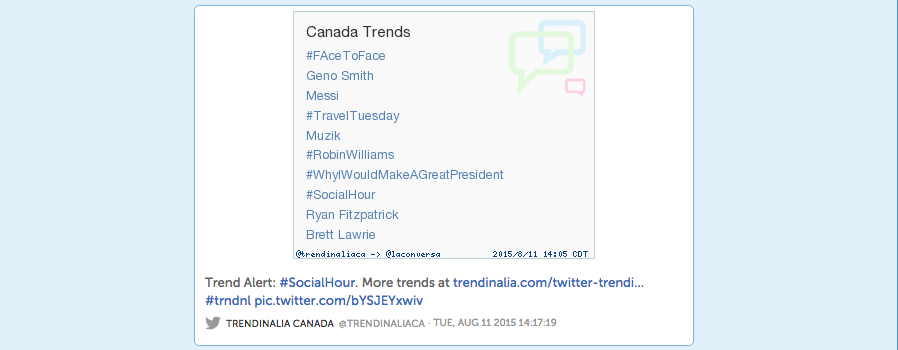
My elation aside, hosting my first chat was a huge learning experience, to say the very least. I did a ton of research up-front and I still felt like I was scrambling to keep up with stuff sometimes.
Real talk though, hosting a Twitter chat is a ton of fun, but it's a lot of work. I had to do a ton of up-front research and a lot of on-the-go learning during the actual chat itself.
With that in mind, I wanted to do a bit of a 'post-mortem' with you to go through how I prepped for my chat, the tools I used (which ones I loved and which ones I won't be using again), and how I'm setting myself up to make sure that next time is an even better time!

Prep, prep, prep
I can't under-emphasize this enough: running a successful chat requires a ton of preparation. Even before you announce the chat itself, there's a ton of up-front work that goes into preparing for a chat to make sure that it's adequately promoted and planned.
Here are the steps I took:
- Figured out my time/date for my chat in advance
- Wrote a blog post explaining what #SocialHour is, how to participate in a Twitter chat, etc
- Created a custom image to announce my chat
- Tweeted about the chat frequently and pinned a Tweet about it on my Twitter profile
- Prepped LOTS of questions and selected several that I wanted to use from the pile
- Pre-wrote my answers (since I have to participate, too)
- Included the #SocialHour hashtag in the prepped Q&A's and did a word count to make sure they fit within 140 characters before I scheduled them
- Scheduled my questions and answers before the chat started so I could focus on engaging participants and moving the conversation along
- Did some research into chat moderation options (more on this below)
Reach out
One of the things that I'm getting over as a business owner is that it's my responsibility to promote myself and my activities, and that it's not "being pushy" or "being salesy" to invite someone to participate in something, or to ask for feedback.
That's precisely what I did: I made a point to reach out to a few people that I know who I thought would enjoy the chat and would be active participants, and followed up with people who had expressed interest in joining. It was as simple as sending a DM with "hey! I'm hosting my first chat called X at X time, I'd really love it if you joined us!"
I also asked participants to provide me with feedback after the fact, and have received a few messages with suggestions and thoughts, which have really helped me hone my ideas for the next chat.
Know which tools to use
Since this was my first chat I was experimenting with a few options to moderate my chat: Twubs, Hootsuite, and regular desktop Twitter. Here's a brief review of how they all worked for me:
Twubs
This tool was pretty much useless. I'd read a ton about it, and it seemed like a viable option, but unless you buy into their 'Basic' plan which is $99/mth it's really not that helpful. All it did was show me a tweet wall and auto-include the hashtag in my replies, which (while helpful) didn't really save me that much time. I also find their website extremely cluttered and annoying to navigate, so I'm unlikely to be using this tool again.
Hootsuite
Hootsuite was pretty helpful fro managing my chat because I could easily create 'streams' for the chat, which meant I had a dedicated #SocialHour stream. It was really helpful to be able to see everything at once: my replies, what I had scheduled to go out, and the activity on the #SocialHour stream.
I definitely made the right choice scheduling my questions and answers in advance, but ran into an issue where my answers sometimes posted before my questions, even though they hadn't been scheduled in that order - Hootsuite only allows you to schedule content in 5-minute intervals, so I figured if I scheduled two tweets to go out at 1pm in a specific order, then they'd post that way. Apparently not. So I had to manually take out the Answers and then paste them in after I saw the auto-posted Question. This added some seriously unnecessary hassle that complicated things a bit.
Twitter Desktop
I actually used straight-up Twitter more than I did any other tool. I realized pretty quickly that Twubs was out unless I paid for it (sorry, $99/mth for a single monthly chat is more than I'm willing to pay), and Hootsuite got a bit overwhelming at times and didn't refresh super-quick (this might be an issue with Twitter, though, and not their fault.)
I found that the easiest way to stay on top of everything was to park myself on the #SocialHour feed and hang out on the 'Live' stream - this way I saw everything that was being said in real-time and had a pretty good handle on who was saying what, and to whom. I don't think this tactic will scale up very well, though, as the chat begins to grow, so I'll definitely have to look for a suitable alternative.
Recap it afterward
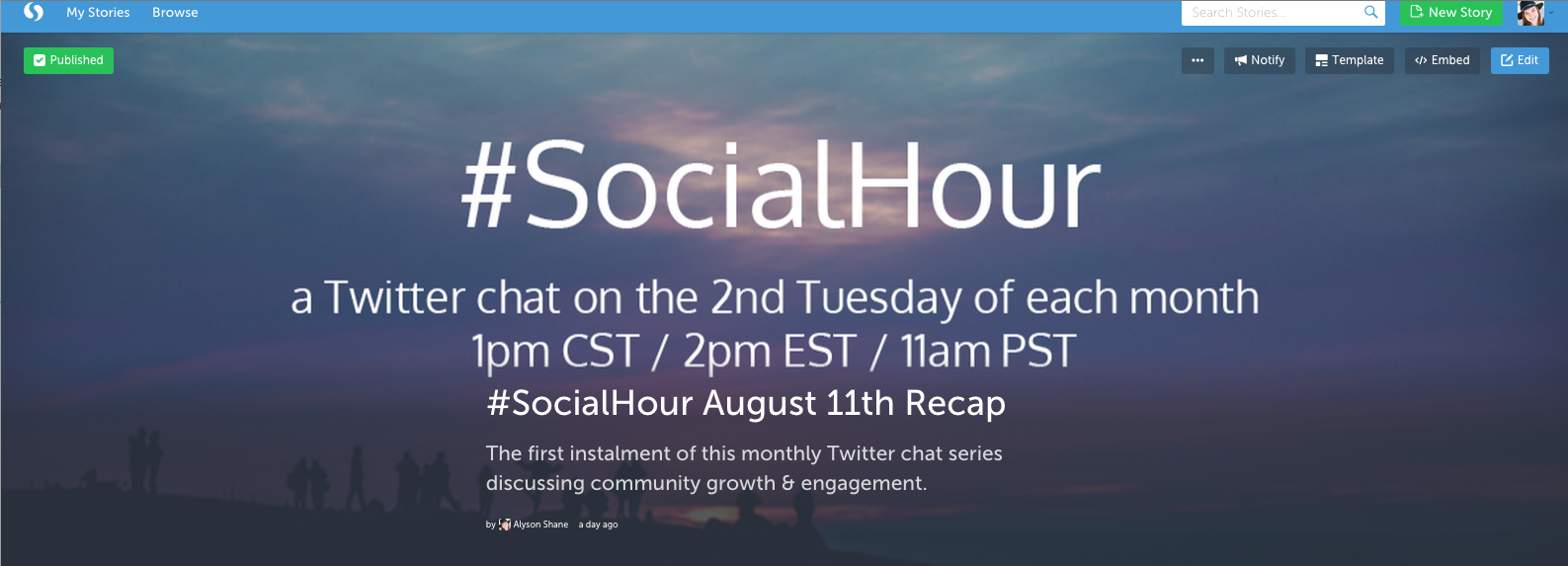
Odds are you'll want to reference your chat for later, and the best tool I've found for this purpose is Storify: if allows me to create a timeline of the chat and save it for others to see. It's also a super-easy format to read, and logs things chronologically, which saves a ton of time.
If you missed the #SocialHour chat, you can find a recap here.
This isn't just an important step for your audience, however; it's also super-helpful to be able to go back over a chat and see trends and themes that emerged, your most active participants, etc. Being able to sit back after all the madness has ended (ideally with a cup of something delicious) and take the time to peruse how things went is invaluable. Here's some stuff to look for:
- How many participants did your chat have?
- Which questions resulted in the most responses?
- Did other topics come up that might be worth discussing in a future chat?
- Which participants in your chat were the most active?
By tracking your chats over time you can start to develop an in-depth insight into the kinds of topics, questions, and conversations will result in higher levels of engagement, which helps your chat grow and succeed!
Do you have any tips for hosting a Twitter chat, or any favourites that you like to join?
I'd love to know!
Twitter for Beginners (Extra Credit): Delving deeper into Twitter Analytics
- by Alyson Shane
Since I wrapped up my Twitter for Beginners series I've had a handful of people email or or @mention me asking questions about Twitter Analytics.
We discussed the importance of analytics a bit in Part 3, but I thought that since it's come up a few times since, we could do a little 'extra credit' session and share a little more in-depth insight into how to read your analytics and make the most of the data!
What you're looking at
Before we delve too much into this post, let's take a second to go over some of the phrases we'll be discussing, and what they actually mean.
- Engagement: The total number of times someone interacted with your tweet (more on this in a few moments)
- Engagement rate: Number of engagements divided by impressions
- Impressions: Times someone saw your tweet in their timeline or search results
- Link clicks: Clicks on a URL or Card in the tweet
- Permalink clicks: Clicks on the tweet permalink
- User profile clicks: Clicks on your name, @handle, or profile photo
- Detail expands: Clicks on the tweet to view more details
- Embedded media clicks: Clicks to view a photo or video in the tweet
- Follows: Whenever you gained a new follower as the result of a tweet
Got it? Good. Let's go!

Get monthly reports
If you check out your account home you can see a quick overview of your Twitter stats. This page shows stuff like monthly average engagement rates, replies, profile visits, etc.
This is pretty standard stuff, but can be really helpful at-a-glance and is great when you need to reference something in a meeting (I do this with my clients often.) It's especially helpful because Twitter will calculate the percentage of increased or decreased engagement, so you can start to dig into why a particular set of tweets earned more impressions, or not.
If you want a more detailed explanation you can check out the Tweets page which shows you much more in-depth metrics. Clicking on a tweet will show you engagement broken down further into ReTweets, Favourites, Clicks on Media, Link Clicks and more.
Measure engagement
One of my favourite features on the home page is the 'Engagements' section on the right-hand side, which breaks down your engagement rate into easy-to-read graphs, percentage points, and an 'on average' recap which gives you a basic idea of how your tweets are performing each day on average.
What does engagement measure? Tons of stuff! Such as:
- ReTweets
- Replies
- Follows
- Favorites
- Links
- Cards
- Hashtags
- Embedded media clicks
- Username clicks
- Profile photo clicks
- Tweet expansions
This is, in my experience, the easiest way to pull pertinent information from Twitter. I use it whenever I'm putting together a report for a client, or when I want to see how I'm doing - once you're used to looking at it I'm sure you'll be just as obsessed with it as I am!
Find out who your influencers are
When you're on the Home page you can get insight into who your top followers are every month in terms of reach, as well as whose @mention to you created the most engagement. You can also look at the Followers page for your Top Follower, which gives you insight into the kinds of people who are following your biggest influencer.
For example, my highest mention this week was from my hilarious pal Kieran, who tweeted this during the recent Canadian Federal Leader's Debate:
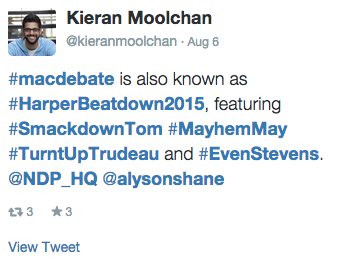
Who should you care? Understanding your top influencers helps you figure out the kinds of people who are active online (and who have active followers, themselves) and the types of people who are most actively engaging with and sharing your content. This type of information can also be helpful when trying to figure out someone to reach out to help you promote an project or collaborate together on an idea.
Get to know your community
If you're trying to grow your community in a specific direction the followers page is your new best friend! it's full of insight into people's top interests, their demographics, and how your followers have grown over time. This last bit of information is especially important if you publish original content regularly or participate in Twitter chats, because you can track what sorts of actions are the most effective at growing your community.
Here are a few key things to look for:
- Which topics your audience are most interested in
- Followers by region (ever have tweets that explode in popularity while you're asleep? This might be why)
- Which language they speak (mine's overwhelmingly English, which makes things easy)
- Who your followers follow (some competitive research never hurts)
See if your posts being re-shared or favourited
Whether or not a post gets Quoted or ReTweeted or Favourited tells a different kind of story about the tweet. Quoting and ReTweeting is generally a sign of value - someone felt that your content was valuable enough to share it with their audience, as well.
Favourites are like virtual fist-bumps: someone liked what you had to say and is giving you props by Favouriting your tweet.
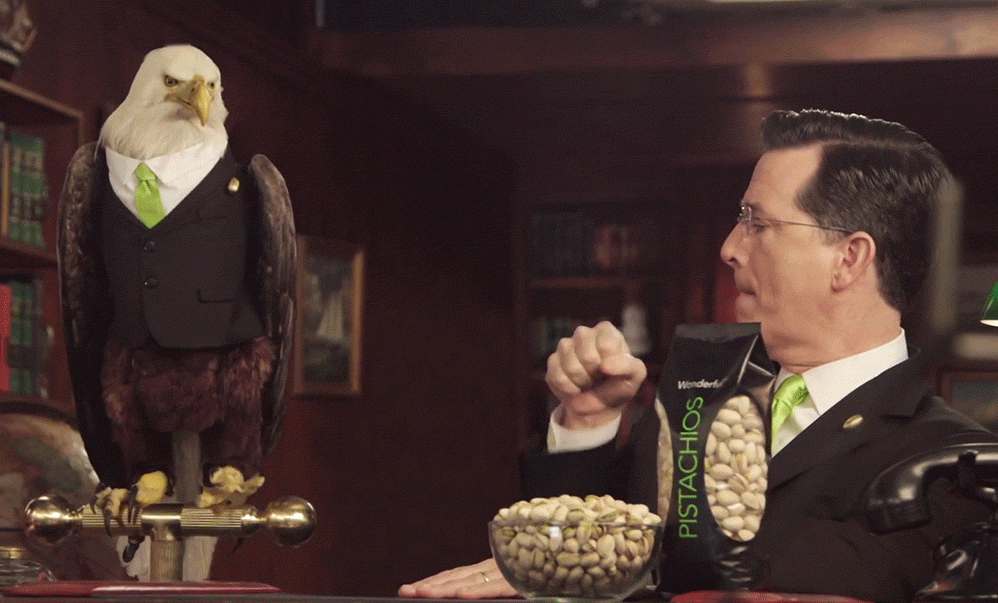
Figure out your "Favourited Rate"
I first read about the "Favourited" Rate theory over on Dave Shure of Evolving SEO's blog, and it totally changed the way that I thought about Favourites. I frequently hear people bemoan the fact that people "just favourite" a post instead of Quoting or ReTweeting it, but favourites can be just as insightful if you approach them this way:
Your followers are going to click 'favourite' for a bunch of reasons, but most likely they're expressing agreement with whatever you said in your tweet. If you track the types of posts that get the most Favourites, you can often find trends emerging which can help guide your decisions when trying to figure out the kind of content to share. This is a huge boon because your audience is directly (if not unintentionally) showing you the kind of content that they like best.
Your turn!
These are just a few of the way that Twitter Analytics can help you figure out how to make the most of your tweets and grow your audience. Go, check out what we've covered here today, and and if you'd like me to cover it drop me a line and I'll get cracking on the next Extra Credit instalment!
PS if we're not already pals on Twitter, make sure to follow me and connect with me there. I love chatting with my readers!
This post is part of the three part series on Twitter for Beginners. Make sure to read part one, part two, and part three as well! The entire series can be found here.
Twitter for Beginners Part 2: Tweeting, Discovering & Making Connections
- by Alyson Shane
Welcome back to my Twitter for Beginners series!
In the first post we discussed how Twitter works and became familiar with the terminology behind what we'll be discussing in this post, so let's get into the real nitty-gritty of starting to build a presence on a social network:
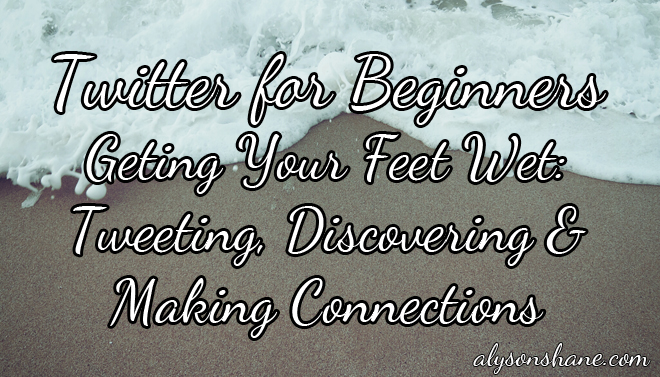
Your Account
Most people join Twitter for personal reasons: to connect with others, promote a business, make friends, etc. Some people join up and create parody accounts, which can revolve around themes or celebrities, but for most of us (and for the purpose of this series) let's just assume that you've signed up to Twitter because you're trying to connect with others and promote your business.
With these goals in mind, your profile should include a recent photo of you, as well as a short bio with links to any work or webpages that you want people to associate with your account.
Here's what my Twitter bio looks like, for example:
It's clear who I am, what I do, and gives potential followers an idea as to what they can expect if they follow me. I've also got a link to my website, because it's one of the places that I want my followers to visit. Try to avoid using too many @mentions or links in your Twitter bio, because it can look messy and disorganized. Try to be direct and use bit.ly to shorten your links if necessary.
Following & Followers
I've described in past posts as being at a party: there are lots of people around, everyone talking in smaller groups about topics that interest them. Like a big party, Twitter can see really daunting when you first show up: who do you talk to? How do you find like-minded people to interact with? What do you say?
Like a party, the easiest way to start talking to new people is to start with the people that you know: follow friends, colleagues, and people whose articles or posts you read online. Once you follow some people you know or are familiar with, take some time to go through their Follower and Following lists and check out the bios of the people they connect with (this is why bios are important).
Following someone doesn't automatically mean that they'll follow you back, but if people keep seeing you pop up in their feed as part of other conversations, or if you keep initiating conversations and participating with the same groups of people, it's likely that they'll start to follow you. The more interesting the content you share, the higher the likelihood that people will want to subscribe to your feed.
Once you've started following some people Twitter will be able to start sorting out your interests based on the people you've chosen, and will start making suggestions based on shared connections or interests. On Twitter's current desktop layout you can find this suggestion bar on the top right corner:
Remember: just because someone follows you doesn't mean that you have to follow them back if you don't want to. Twitter is about curating the kinds of conversations and information that you want to see, and just like how you can leave a conversation if it starts to get boring or uninteresting at a party, Twitter gives you the same option.
Try and be mindful of your Following to Follower ratio: this sounds frivolous, but if you're following a high number of people and have very few followers it looks desperate. When you're starting out, try to keep those numbers about even, but as you gain more followers try to keep your 'Following' number less than your 'Followers.' Public perception can go a long way online.
Tweeting & Connecting
Now that you've spent some time building a list of people to follow, it's time to start participating! While it might seem easier to start sending off 140-character thoughts or observations, the key to growing your Twitter community is engaging with others, especially at the start.
The best way to do this is to hit 'reply' to a Tweet that catches your eye. Maybe a friend shared a cool article, or made an observation you agree with. It's as easy as saying "yeah, that article about goats was really interesting!" or "I also enjoyed the fish tacos at that truck stand on Broadway" and you're off to the races.
If people on your feed are participating in a larger conversation their tweets will be connected by a thin line, like this:
If there are more than three messages in a conversation, Twitter will display a "view conversation" button, which will allow you to see what's been said previously, to give you some context of what's been said. In my experience, this is the thing that trips people up the most: they don't feel comfortable "entering" a conversation and adding their two cents.
Just start talking to people. If you see a conversation that you think is interesting, or is taking place between two people that you want to talk to, just @mention them and say your piece! Twitter is generally a pretty friendly place and nobody is going to judge you, think poorly of you, or (in most cases) be mean to you for simply joining a conversation.
Engaging with a variety of people increases your exposure. The people you're tweeting to might reply to you, which means your twitter handle will show up in their reply, or ReTweet (RT) or Quote you, which will share whatever you've just said with their network of followers. When other people see people they follow interacting with someone, they're more likely to start to engage with that person, too.
The key to tweeting is consistency: you need to be an active member in order for people to see your twitter handle on a regular enough basis that they want to start connecting with you. Try to tweet several times a day, at least, and be as varied with your content as possible: share news articles, photos, quotes, as well as reply and comment on things that others have shared.
Here are a few daily Twitter goals to help you grow:
- Tweet at least several times a day
- Have some variety in what you share: include links, photos, gifs, RTs and Quotes whenever possible.
- Follow at least one new person a day
- Participate in a conversation relevant to your niche with a trending hashtag (#)
Muting & Blocking
'Muting' someone on Twitter means that a specific Twitter user's tweets won't show up in your timeline. The muted user can still see your content, favourite it, and send you mentions or @replies (though you won't receive a "push" notification when they do.) You can mute someone without unfollowing them and without notifying them, which can go a long way if a colleague isn't that interesting or you don't want to offend a friend by unsubscribing to their slew of hockey-related tweets.
Blocking someone takes things to the next level. If someone starts harassing you, bothering you, or you simply don't want to interact with them anymore, you have the option to block that account from seeing your Tweets, and you from seeing theirs.
If you block someone they can visit your profile page and see that they've been blocked, whereas if you mute someone they will assume that it's business as usual because nothing will appear to have changed on their end. Try to be mindful of who you block or mute, but at the same time don't put up with any abuse - if you feel like someone is harassing you, or posting inappropriate content, report them to Twitter and block them immediately.
No amount of social clout is worth staying connected to a bully or someone who makes you feel uncomfortable or unsafe online
Tailored Trends
If you're using Twitter on your desktop you might have noticed a tab to the left of your feed called 'Trends.' This can be a really powerful tool for finding share-able content and keeping on top of conversations which are relevant to your interests.
By clicking on the "Change" button inside the Trends box you can begin tailoring what you see to your location (in my case it's Winnipeg) or larger, more popular trends on across Twitter's communities. By following and tweeting about popular topics within your network or niche you increase the likelihood that someone else with the same interests will see it and add you to their network.
Understanding what people are talking about you can make sure that you're able to add your voice to the conversation and be heard; you'll know which hashtags to use and which topics they refer to, so your tweets can be consistent and clear.
Now you're tweeting - congrats!
You're started getting your feet wet with Twitter; you're tweeting a few times a day, following new people, and starting to become more comfortable with a 140 character limit.
That's great, but there's still lots to discuss:
How do you define your 'voice' on Twitter?
What the heck is a 'Twitter Chat"?
Should you use third-party applications? Which ones?
Is there a benefit to using Lists?
and more, which will be covered in the final instalment of my Twitter for Beginners series:

This post is part of the three part series on Twitter for Beginners. Make sure to read part one, part three, and the extra credit as well! The entire series can be found here.
Twitter for Beginners Part 1: Getting Started
- by Alyson Shane
I get asked a lot about my preference of social media platform; namely, which one do I feel is most effective for getting your voice out there and starting to build an audience for yourself.
My favourite, hands down, is Twitter. I love Twitter.
The problem is, I often find that I'm the only one. When I tell people that I love Twitter above all the rest their eyes usually get big and they something like "I don't get Twitter" or "Twitter is too hard!"
So with that in mind, I'm going to be doing a series of Twitter for Beginners posts about this topic: we'll focus not just on how to use this important tool, but also why we should be using it, and best practices for first-time tweeters.
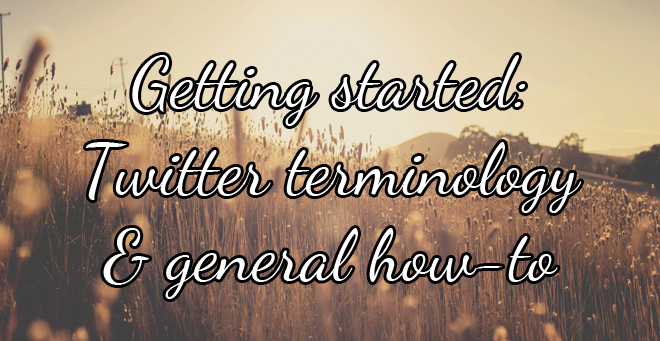
Twitter Terminology
Twitter has a lot of terminology and rules specific to its platform, which is one of the main reasons that so many people steer clear of using it (or don't use it effectively). Here are the basics:
Tweet: a tweet (like the bird logo, get it?) is the body of your message. It can be text, numbers, or characters but it has to remain under 140 characters in total. This is what a lot of people struggle with, because it can be tricky to boil your thoughts down to such a narrow limit.
This, however, is what makes Twitter such a valuable tool. Because you can't ramble on forever and are forced to be concise, the conversations on Twitter flow a lot more quickly and the focus is more on sharing a link to a separate, longer article or thought piece than about making a single statement.
Twitter handle: this is your username on Twitter. It refers to the name that you've chosen and the @symbol that precedes it. For example, mine is @alysonshane.
The @ symbol before your name is how Twitter recognizes that the name or words of your handle are associated with your account.
Mention (@mention): a mention is when you post a public message on Twitter and include someone's Twitter handle in the body of your tweet. When you @mention someone, they receive a notification and (in theory) will begin participating in the discussion.
So if I wanted to tweet at you I would type "hey @yourtwittername, hope you have a great week!" and Twitter would know that because I typed a @ followed by a user name, then I'm tweeting at someone, which is the Twitter equivalent of initiating a conversation with them.
Best practice here is to only @mention people who you know, or who are directly related to what you're tweeting about (eg: article authors, people involved with an event, etc). Tweeting randomly at people is a Twitter faux-pas, and should be avoided (we'll go into more of this later).
Twitter Feed: Your 'feed' is the aggregate of posts from people that you follow, which is displayed on your home page. By paying attention to your feed you can see up-to-date posts in chronological order, which helps you keep track of who said what and when.
ReTweet (RT): A ReTweet is creating a carbon copy of someone else's tweet, which gets shared on your own timeline. This serves as an easy way of sharing links, content, or otherwise showing that you agree with whatever is in the body of the tweet.
Twitter also allows a "Quote" option for ReTweets, which allows you to write your own tweet while including a photo (and link to) the original tweet in your post.
For example, here is a quoted retweet of mine that includes my own comments as well:
Hashtags (#): A hashtag (or # symbol) is a tool for participating in a conversation. A hashtag instantly connects a social media post to a group of others about the same topic, and connects the person sharing it (you) with other people talking about the same topic in real-time.
Brands, companies and individuals all use hashtags as a way of talking to a larger group of people, or of promoting themselves. For example, the sports equipment company Nike frequently includes #justdoit in their tweets. "Just Do It" is Nike's slogan, and helps people understand that what they are sharing is part of a larger narrative.
For more detailed info on hashtags and how to use them, check out my longer, more detailed post on it here.
Direct Message (DM): A Direct Message is a 140 character private message between two people who follow each other.
Most people believe that two people need to be following each other in order to message privately, but there's a feature under Settings > Security & Privacy called "Receive Direct Messages from anyone" which, if selected, allows you to (big surprise) receive messages from any Twitter user even if you don't follow them.
Keep in mind that while still technically "private" a Direct Message can still be saved as a screenshot and shared elsewhere, so be wary of what you DM to your fellow Twitter users. Don't become the next Anthony Weiner!
So we've gone over the basics and you're ready to sign up and start tweeting!
But what do you say?
Who do you say it to?
How do you attract new followers
What can you do to help them find you?
How do you use all of the tools that we've just discussed effectively?
We'll be going over all of that in greater detail in the second installment of this series:
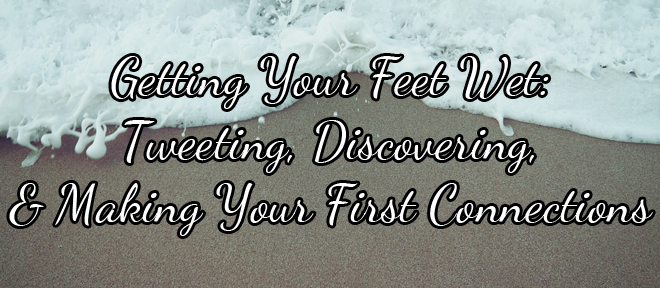
This post is part of the three part series on Twitter for Beginners. Make sure to read part two, part three, and the extra credit as well! The entire series can be found here.
The Power of the Hashtag
- by Alyson Shane
In the last few years the use of the "hashtag" (the # symbol - previously called the 'Pound Sign' if you're a fossil like me and used a push-tone phone growing up) has exploded in popularity. Unless you live under a rock you've likely been bombarded with the hashtag symbol everywhere - on commercials, billboards, on social media, on clothes... these days the "hashtag" is one of the most pervasive and powerful symbols of our digital age.
Despite seeing hashtags everywhere, most people don't understand their importance or how to harness their power to help them convey their message across social media platforms. A simple hashtag can improve your reach, drive brand recognition, and easily engage in large-scale conversations online.

#Why?
If you're a business owner or someone hoping to expand their social media influence, a hashtag should be an important part of your social media strategy. This is because a fitting hashtag can help drive brand recognition, drive customer loyalty, and help spread the word about your idea or product.
A hashtag instantly connects a social media post to a group of others about the same topic, and connects the person sharing it (you) with other people talking about the same topic in real-time.
What this means is that you can include a simple hashtag in your social media post and immediately have it seen by anyone else looking for that hashtag. Here's an example using Twitter:
Above is a tweet that I just created which includes the #SocialMedia hashtag. When I tweet something that includes a hashtag, the hashtag works like a link which allows people to click on it and find other tweets relating to the same subject.
When I click through on the # link Twitter takes me to a page filled with other tweets which include a "#SocialMedia" tag. The "live" feed (people using it in real-time) looks like this:
As we can see, my #SocialMedia hashtag allows me to connect with other people who are tweeting about the same subject, and for others to find my tweet as well. Twitter also offers search options to refine what you want to see from that topic.
Hashtags first started to become commonplace on Twitter as a way to link ideas and conversations in the way that I just described, but other social platforms like Facebook and Instagram have also adopted using them as well.
#How
Even if you know why a hashtag is important, it isn't going to do you much good if you don't know how to use it effectively. In fact, when misused you can actually drive people away from your message because too many hashtags feels spammy (more on that in a second.)
Here's are some ground rules for making sure you're using hashtags to their full usefulness:
- Use the hashtag (#) before relevant words or phrases to categorize posts and help them show up in a search (like in my previous example).
- A hashtag can be included anywhere in the message - they don't have to be stuck at the beginning or at the end if you can work them into the body of your message.
- A hashtag won't appear in a search if your profiles are protected or private.
#Etiquette
Don't #spam #with #hashtags.

(via Google. I have no idea who this poor soul is)
Don't over-tag a single post. Twitter's best practices recommend no more than two per tweet, and in addition to being visually unappealing it also dilutes your message. Using too many hashtags dilutes the meaning of your message because you're trying to appeal to too many ideas at once.
An exception to this rule is Instagram, in which photos with at least eleven (yeah, 11!) hashtags get the most interaction. This is because Instagram doesn't have a character limit for captions on their photos, and because hashtags are the easiest way for its communities to connect with one another
The trick do doing this effectively, however, isn't to include a million hashtags in your original photo post, but rather to include a comment with your wall of hashtags afterward. This ensures that if you're sharing your photo on other social platforms the people seeing it there aren't bombarded with a dozen messy-looking hashtags. That way you're still able to connect with your Insta-communities, but are also saving some face on any other social networks your photos might be sharing to.
What can you do?
Pick a specific hashtag. If you want to start using hashtags to raise awareness for your product, brand or project, pick a specific hashtag and use it exclusively, or with one other hashtag in the body of your post. Make it unique, relevant to what you're talking about and easy to remember.
Start a Twitter Chat. If you're active on Twitter, another great option is to start Twitter chats using a hashtag specific to the theme you want to discuss. These chats operate like live Q&A's on Twitter which are organized around a specific hashtag. For instance, I participate in a Twitter conversation with other Canadian bloggers every week called #blogchatca - the hashtag is easy to include and remember, and allows me to find other people participating in the conversation and respond to them. By including the hashtag #blogchatca I know we're all participating in the same conversation.
Pick something obvious. Make sure that your hashtag is short, easy to remember, and (if possible) unique to whatever you're discussing. For example, this past weekend I participated in a game jam where the official hashtag was #GameJam. This is great because it's easy to remember and find, but it's a pretty widely-used hashtag because many game jams happen at the same time. As a result, many people tweeting about the game jam I attended started using #PegJam to indicate that they were at a game jam in (you guessed it) Winnipeg. This way everyone could find each other easily and see what others were sharing and discussing.
Do you have any tips on hashtag use? Anything you'd avoid doing? I'd love to hear your thoughts!
5 Twitter Mistakes That Bloggers Make
- by Alyson Shane
Even if you've been consistently creating great blog content for a while, these days it can be virtually impossible to grow your blog readership without creating profiles on various social media sites and engaging with people on those platforms.
However, just because you have a Twitter account doesn't mean that you're using it to it's full potential. In fact, you might be unknowingly committing some serious social media faux-pas and turning potential readers away from your website!
Below are a few quick and simple steps that you can take to make sure that you're getting the most out of Twitter and bringing new readers to your blog on a consistent basis:

1. Sending Automated Direct Messages
There are a lot of instances where automation can save you a ton of time, but automated direct messages aren't a place where you should be investing your energy. The reason is this: sending an automated, direct message tells people that you don't think that they're worth your time to engage with.
If you send every new follower an automated direct message that says something like "Hey! Thanks for the follow, why don't you check out my blog at [yourbloghere].com!" you might think that you're being polite and conversational, but what you're actually doing is spamming them with your content. They've chosen to follow you for a reason (a funny tweet, mutual followers, something you wrote, etc) and an impersonal direct message says to them "I don't care enough to tweet at you directly in public, but please go support my work anyway."
If you want to say hello to every new follower (and that's totally fine!) then make a point to do so publicly, positively, and keep your self-promotion for other tweets.
2. Auto-Following Back
Contrary to what many Twitter users think, your Following vs Follower ratio doesn't have to be the same, and it's not rude to not follow someone who recently followed you if their profile and tweets don't match up with the sort of content you want to see and engage with on your feed.
For example, if you're a fashion blogger it might not be beneficial for you to fill your feed with tweets about NASCAR and pro-wrestling (that is, unless you're a fashion maven who is also into NASCAR and pro-wrestling, in which case, keep doing your thing!)
You can easily grow your audience by tailoring the people that you follow and interact with to fit your blogging goals.
Twitter isn't a competition, and the person following the most people doesn't win at social media - in fact, what it likely does is dilute their ability to engage with others and have real, meaningful conversations. Only follow back if you mean it.
3. Never Engaging with Your Followers
The most important thing to remember when using Twitter is that it is a social network first and foremost. This means that you have to interact with, share content from, and ask questions to the people you follow. Simply tweeting out into the void isn't going to bring anyone to your website; you have to engage with people and give them a reason to click through to your content.
On the flip side, a major downside to having a lot of Twitter followers is that it's virtually impossible to interact with every one of your followers. The best solution is to create lists and add your favourite Twitter users to them so that you can easily stay up-to-date with what they're tweeting.
4. Only Talking About Yourself
This is the worst mistake that bloggers (and anyone, really) can make on any social platform, but Twitter makes this habit much more obvious because your timeline looks so condensed on your page.
For instance, if I visit a person's Twitter profile and all I see are a series of tweets that are essentially "thought bubbles" (eg: "I love Big Macs!" "Today was going great until I got splashed by that bus," "nobody ever visits my blog") with no interaction with anyone else I'm not going to follow them because they're obviously not contributing to a larger community - they're just using Twitter as a soapbox.
Do not use Twitter as a soapbox. It's a social tool and is insanely effective for growing your audience and expanding your readership when used effectively, and that means spending the time to get to know the people in your online community - ask questions, share interesting posts, congratulate people on their successes!
5. Tagging People in Your Tweets
When you post a tweet with a link to a new blog post, it's only okay to tag someone in the body of your tweet if they are involved with the post somehow. For example, if you reviwed an album you can tag the artist in the tweet, or if you interviewed someone you can tag them to let them know you've posted their interview.
If you're simply tweeting at your followers and other random people about your content it's more likely that they will unfollow you than click through to your post. This is because you aren't providing them with a reason why they should click through to read, you're simply tagging them with the expectation that a simple mention is enough to pique their interest.
The trick to get people to read is to build your audience by engaging with your Twitter followers on a consistent basis and showing them why they should care about your blog. Your Tweets should show people that you're a super cool, funny and interesting person (because you are, obviously), and because your blog is a larger extension of that persona people will naturally want to see more of what you have to say than what you can express in 140 characters.
To Sum It All Up
You can't force people to start caring about what you have to say, but by engaging with them and showing them that you're an interesting, caring individual they will naturally make the jump from being Twitter followers to blog readers and even newsletter subscribers.
This will take time and a fair bit of effort, but in addition to new hits to your site you will also be developing a larger network of interesting people who you can engage with to help you grow and succeed in your endeavours.
Do you have anything to add to this list? Have you ever had a bad experience on Twitter? I'd love to hear about it!
7 Steps to Grow Your Social Influence
- by Alyson Shane
Back in the days of yore (read: pre-social media times) most of what we did in our non-work hours stayed that way. Our professional and personal lives rarely mixed.
These days, those lines keeping parts of our lives separate have begun to blur, and we are constantly Tweeting, Snapchatting, posting, watching, sharing... you name it, we're likely doing it in one form or another online. While this means that we have the ability to be more social, it also has larger implications for how we are percieved by our peers, potential employers, and clients online as well.
Whether or not we would like to admit is, how we act online plays a big part in contributing to our professional reputations. People will judge based on the sum total of what you're shared online, and the internet never forgets - even if you delete what you've posted, it's still out there.
With that in mind, here are a few tricks that I've picked up to manage my activities online and to use my social media profiles to grow my influence:
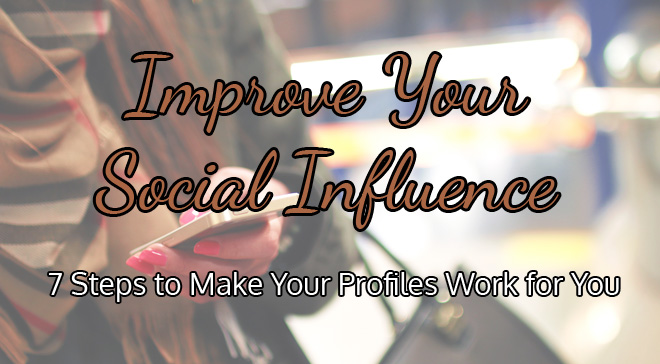
1. Create and Curate Your Profiles
Are the social platforms that you hang out on the ones that are most beneficial to you and your professional goals? It's likely that you're already on Facebook, Twitter, and LinkedIn, but if you're in the food, travel, fashion or lifestyle business, you should also have an active Instagram and Pinterest account, with relevant and up-to-date profiles on each.
The trick to using all of these platforms is to present yourself as someone interesting who knows how to use each of their social platforms in the best way possible. Edit your profiles to fit with your goals for each social platform and include links, if possible, as well as a well-taken photograph of yourself.
2. Share Your Content
Facebook, Twitter and Instagram operate essentially as "show and tell" platforms for content, so if you just knitted a great kitty sweater for your Etsy store or wrote a terrific blog post reviewing all the Air BnB locations in Thailand, share it and show your networks your skills.
In particular, content that educates, entertains, or encourages people will recieve a better reception than something which is self-serving or pitches a product. For example, if every other post is a plea for someone to buy your book, it's more likely that they will start ignoring you than your post will suddenly inspire them to log into Amazon.
3. Be Nice
In order for people to care about you, you have to care about them. Be genuinely interested in what others in your community or profession are doing, and don't hesitate to share their successes across your networks.When you are actively sharing and being interested in other people it will encourage them to do the same for you, because you are demonstrating not only that you're interested in them, but that you are willing to help them share their successes by showcasing or congratulating them on your network for everyone there to see. At the end of the day, people want to see nice people succeed, and the quickest way to success is to actively be nice to everyone you meet.
4. Be a Part of a Community
Social media is social first and media second. What I mean by this is make sure that you're using social media to build relationships, not just to broadcast your successes or thoughts.
For example, every Tuesday morning on the way in to work I participate in #blogchatca, a (you guessed it) Twitter conversation about blogging. I'm also a part of Kyla Roma's Daring Creative facebook group, and participate in the monthly #DaringCreative twitter chats she hosts as well. Being a part of these communities not only expands my network to people that I might not have otherwise been able to connect with, but also allows me to develop relationships with people over a shared interest and connection
5. Be Generous with Your Knowledge
One of the amazing things about digital communities is the amount of knowledge that has become available as a result of sharing online. I've found that in a lot of circles this has led to a "pay it forward" model of sharing information - that is, that openly giving and sharing your knowledge will pay off for you in the end.
Generously share news, knowledge, tips or other pieces of information that you think will help others achieve their goals. This not only helps others, but also works to build your social profile as someone who now only knows what they're talking about, but is confident enough in that knowledge to be willing to help others learn, as well.
6. Be Consistent
Being consistent means committing to a certain schedule of publishing and sharing content regardless of how you feel. We all have slumps and bad days (and hey, even I take a break from Twitter if my day is jam-packed) but what matters is that over the long-term you have a consistent presence online.
This not only means posting and sharing content, but also responding to people who contact you and having the discipline to do so in a way that is in line with your persona. Eg: don't use excessive offensive language, don't snap at or belittle people because you're having a bad day, etc.
Which brings me to my next point:
7. Keep Negative Thoughts Private
Venting online, "vaguebooking" or "vague-tweeting" (posting passive-aggressive stuff without stating who you are directing it at), etc is not okay. Don't do it.
If you've been online for any length of time you've probably engaged in this sort of behaviour before (it's okay, I have, too, once upon a time) but it's time to grow up and start behaving like adults online.
The reason behind it is this: you never know who is reading your content. You might think that your Facebook is friends-only, but how do you know that a friend-of-a-friend won't see an inside joke and take offense? Or that slanderous thing you Tweeted about a co-worker might be a little too specific, and you might find yourself out of a job. Better to be safe than sorry.
In addition to potentially landing you in hot water, having a negative online persona has long-lasting consequences: people will think of your negative, snarky comments before they think of a helpful link that you posted, so even if you're generally positive online a bad day or a slew of passive-aggressive comments can destroy the online reputation you've worked so hard at building.
There are a multitude of ways in which your bad attitude could backfire, so it's safest to keep it offline completely (or, focus on being more positive.)
These are just a few steps that you can take to start expanding your social reach and growing your influence online. Do you have any suggestions? I'd love to hear them!
